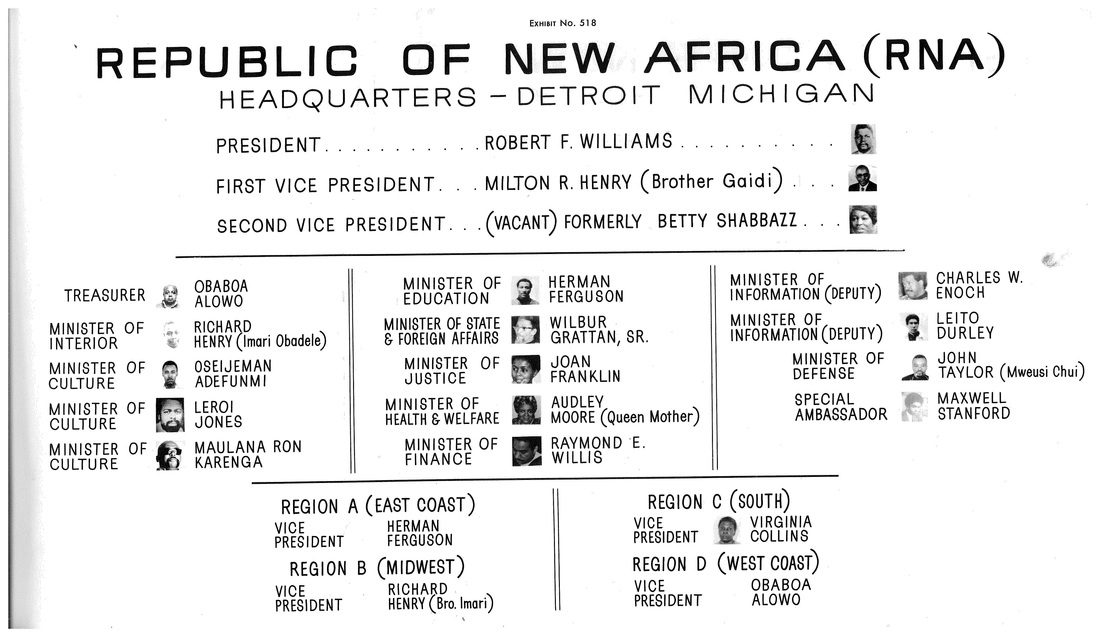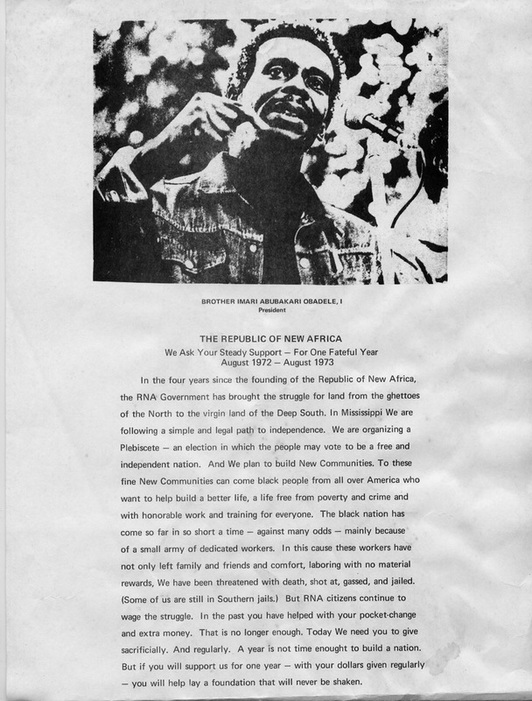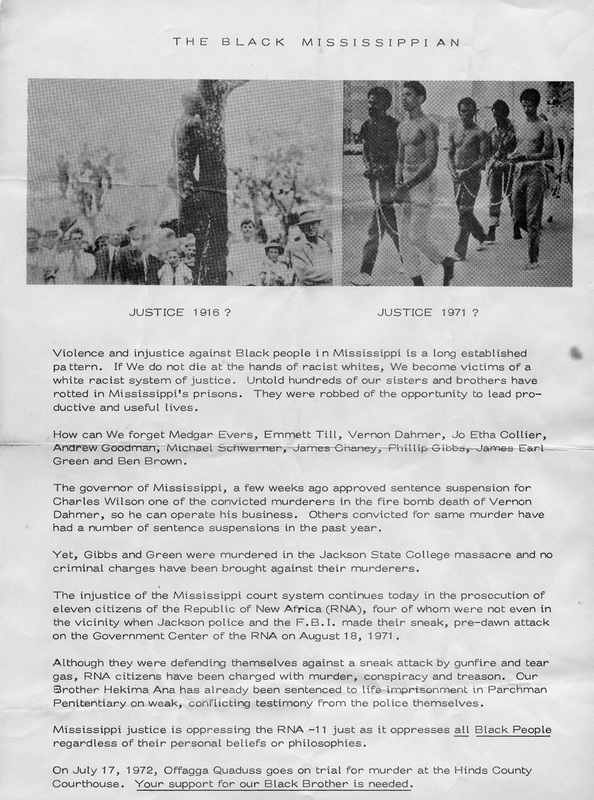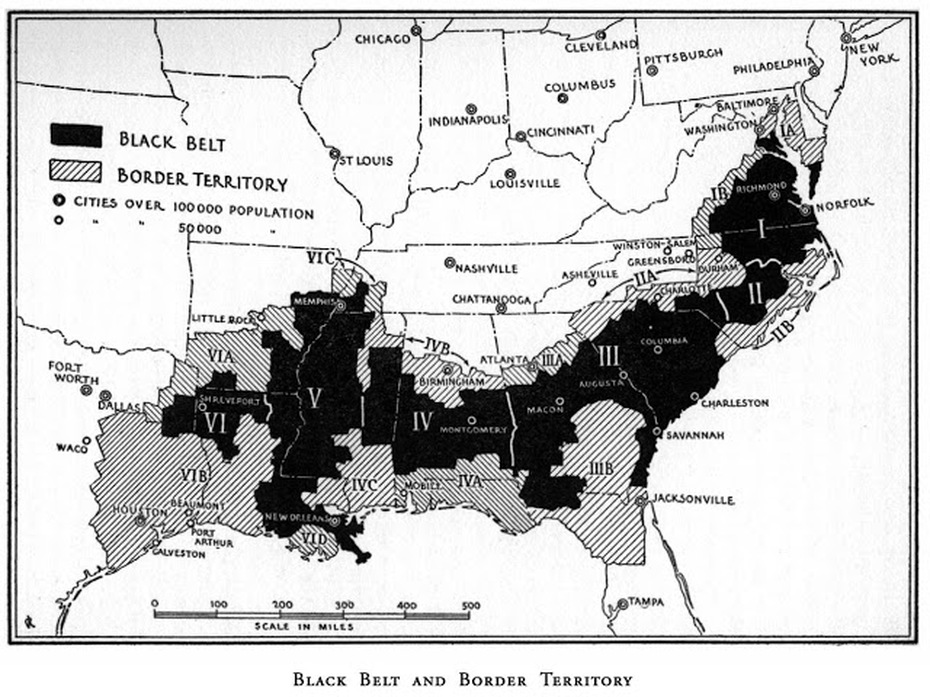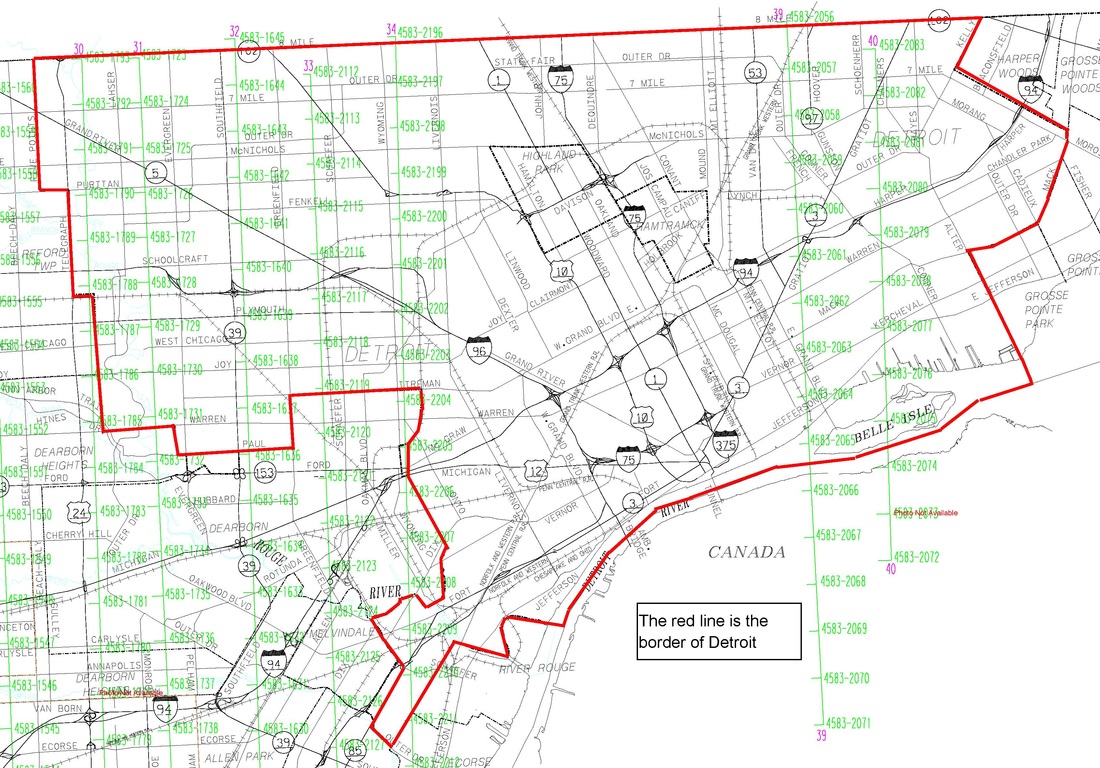The Republic of New Africa vs.
the U.S. Government in Space and Time, 1968-1973
The impetus for this project came from a series of conversations with different activists who prompted me to rethink the dynamic interaction between governments and challengers. They suggested to me that repression was important for movements but not in the ways that I thought. They argued for a more complex investigation - one that dove deeply into the institutions, individuals and interactions that took place both within movements as well as between those who challenged governments and those who protected them.
For this project, with support from the National Science Foundation, I compiled data from arrest, surveillance, and informant reports as well as movement records concerning the Republic of New Africa - a black, nationalist, and secessionist movement based in Detroit, Michigan, from 1968-1973 (by the day and, generally, the hour). This case proves particularly interesting for it takes place within a political opportunity structure that most would deem "closed" (with increased repressive applications and the development of particular police agencies), with limited mobilizing structures (after the decline of civil rights organizations), and with a historically neglected cultural frame (U.S. nationalism). The data allows the exploration of everyday group dynamics as all the group meetings provide information about who was there, what was said, when the meeting started/ended, and occasionally how individuals responded to each other in non-verbal fashion. The activity that precedes and follows protest behavior is thus documented, allowing us to investigate what cultural framing activity, what aspects of mobilizing structures, and what political opportunities are relevant to different stages in the social movement process as well as what influence repression really has on the internal workings of dissident organizations. The records also provide detail information about state repression - specifically, who did what to whom.
Enjoy
[Christian Davenport]
Professor of Political Science - University of Michigan
Faculty Associate - Center for Political Studies, Institute for Social Research
Research Professor & Global Fellow - Peace Research Institute Oslo (PRIO)
Director - Radical Information Project (RIP)
Director - Stop Our States (SOS)
Co-Founder - New Jack Academics with Professor Darren Davis
Co-Founder - .EDU: opening minds & changing worlds with style with Professor Jillian Schwedler & Rodney Williams
Co-Founder/Director - Conflict Consortium (CC) with Professor Will Moore
For this project, with support from the National Science Foundation, I compiled data from arrest, surveillance, and informant reports as well as movement records concerning the Republic of New Africa - a black, nationalist, and secessionist movement based in Detroit, Michigan, from 1968-1973 (by the day and, generally, the hour). This case proves particularly interesting for it takes place within a political opportunity structure that most would deem "closed" (with increased repressive applications and the development of particular police agencies), with limited mobilizing structures (after the decline of civil rights organizations), and with a historically neglected cultural frame (U.S. nationalism). The data allows the exploration of everyday group dynamics as all the group meetings provide information about who was there, what was said, when the meeting started/ended, and occasionally how individuals responded to each other in non-verbal fashion. The activity that precedes and follows protest behavior is thus documented, allowing us to investigate what cultural framing activity, what aspects of mobilizing structures, and what political opportunities are relevant to different stages in the social movement process as well as what influence repression really has on the internal workings of dissident organizations. The records also provide detail information about state repression - specifically, who did what to whom.
Enjoy
[Christian Davenport]
Professor of Political Science - University of Michigan
Faculty Associate - Center for Political Studies, Institute for Social Research
Research Professor & Global Fellow - Peace Research Institute Oslo (PRIO)
Director - Radical Information Project (RIP)
Director - Stop Our States (SOS)
Co-Founder - New Jack Academics with Professor Darren Davis
Co-Founder - .EDU: opening minds & changing worlds with style with Professor Jillian Schwedler & Rodney Williams
Co-Founder/Director - Conflict Consortium (CC) with Professor Will Moore
The Republic of New Africa (RNA)
In 1968 a group of African Americans came together in Detroit to form the Republic of New Africa (hereafter RNA). The objective of this organization was simple: secede from the US, claim 5 states for the new nation, obtain hundreds of millions for reparations for the damage done by/since slavery and have a plebiscite of all African Americans to see whether or not they wanted to join. The objectives were ambitious and the tactics associated with them bold: Afrocentric education, repeated conferences on nation building and standing up to police raids. Initially the group received a significant amount of attention from local, state and federal media. There was also a significant buzz among the African American community. Indeed, by 1968 black nationalism had risen in popularity over the more moderate Civil Rights movement and African Americans began to flock to organizations like the RNA.
RNA Organizational Chart from Senate Investigation
Diverse Literature from the RNA (in PDF)
RNA Fliers 1
RNA Fliers 2
Miscellaneous Information 1 (varied quality)
Miscellaneous Information 2 (varied quality)
RNA Fliers 2
Miscellaneous Information 1 (varied quality)
Miscellaneous Information 2 (varied quality)
Red Squad Records
Lumped under the general category of the black nationalist or hate group, the RNA was subject to a wide number of repressive activities including physical and electronic surveillance as well as informants and agents provocateur raids, mass arrests and shootouts. The rate and intensity of government action was nothing at the level of an organization like the Black Panther Party which was heralded as the “most dangerous organization in the US” at the time but nevertheless the behavior directed against the organization was not inconsequential.
Most of the activities directed against the organization were implemented by what were referred to as "Red Squads" - anti-radical police units. The explicit objective of the Red Squad was twofold: 1) the monitoring of behavior that was deemed radical in its intent, violent or relevant to “national security” (Donner 1990, 3); and 2) the elimination of targets. These records were compiled from diverse organizations principally based within cities but extending up to state and federal levels, across diverse aspects of government. This includes police departments, judicial institutions (e.g., the Justice Department and district courts), intelligence organizations (e.g., the FBI, CIA, State Department and the Army) and the Internal Revenue Service.
As discussed by Donner (1990, 291), “The Detroit Red Squad underwent enormous growth in the sixties in response to New Left and black protest activities.” He continues:
Prior to the 1967 outbreak (riot/rebellion), the Detroit police had recognized the need to monitor the mounting civil rights demonstrations and for that purpose had formed a demonstration detail within the Special Investigation Bureau (SIB) that functionally overlapped the responsibilities of an established subversive unit in the Criminal Investigation Bureau Donner (1990, 292).
This shifted after 1967, however, as the units as well as their activities expanded. Accordingly:
Activities of the New Left and black protest movements became major concentrations, overshadowing the old (communist) left and labor activists. File collections – individual and organizational, “subjects” and events – grew enormously, as did data exchange. The old liaison networks were revitalized with new ties (to Army intelligence) and much closer ones with state and area police generally, as well as with college units such as the Wayne State University campus security police (Donner 1990, 292-3).
Further elaborating on what was undertaken, Donner notes that (1990: 295):
The information collected by the squad concerning individuals or organizations was stored in master files, which bulged with inter-office memoranda, third party interviews (utilities, employers, landlords), newspaper clippings, documents and literature “lifted” by informers, and a variety of public records. Filed information included a subject’s address, spouse, vital statistics, criminal history (if any), and a photograph when available. In addition, such personal information as “localities frequented,” friends, personal characteristics, and traits were recorded.
The records themselves are composed of different types of documents. Some are informant reports from diverse local (i.e., Detroit Police Department [Special Investigations, Demonstration Detail, Intelligence Division, Inspectional Service Bureau, Security Unit, Detective Division, Criminal Division, Public Complaints Division, and Tactical Reconnaissance]), state (i.e., Michigan State Police [Special Investigation Bureau, Special Investigation Unit]) and federal institutions (i.e., the FBI, the IRS and US State Department).
Most of the activities directed against the organization were implemented by what were referred to as "Red Squads" - anti-radical police units. The explicit objective of the Red Squad was twofold: 1) the monitoring of behavior that was deemed radical in its intent, violent or relevant to “national security” (Donner 1990, 3); and 2) the elimination of targets. These records were compiled from diverse organizations principally based within cities but extending up to state and federal levels, across diverse aspects of government. This includes police departments, judicial institutions (e.g., the Justice Department and district courts), intelligence organizations (e.g., the FBI, CIA, State Department and the Army) and the Internal Revenue Service.
As discussed by Donner (1990, 291), “The Detroit Red Squad underwent enormous growth in the sixties in response to New Left and black protest activities.” He continues:
Prior to the 1967 outbreak (riot/rebellion), the Detroit police had recognized the need to monitor the mounting civil rights demonstrations and for that purpose had formed a demonstration detail within the Special Investigation Bureau (SIB) that functionally overlapped the responsibilities of an established subversive unit in the Criminal Investigation Bureau Donner (1990, 292).
This shifted after 1967, however, as the units as well as their activities expanded. Accordingly:
Activities of the New Left and black protest movements became major concentrations, overshadowing the old (communist) left and labor activists. File collections – individual and organizational, “subjects” and events – grew enormously, as did data exchange. The old liaison networks were revitalized with new ties (to Army intelligence) and much closer ones with state and area police generally, as well as with college units such as the Wayne State University campus security police (Donner 1990, 292-3).
Further elaborating on what was undertaken, Donner notes that (1990: 295):
The information collected by the squad concerning individuals or organizations was stored in master files, which bulged with inter-office memoranda, third party interviews (utilities, employers, landlords), newspaper clippings, documents and literature “lifted” by informers, and a variety of public records. Filed information included a subject’s address, spouse, vital statistics, criminal history (if any), and a photograph when available. In addition, such personal information as “localities frequented,” friends, personal characteristics, and traits were recorded.
The records themselves are composed of different types of documents. Some are informant reports from diverse local (i.e., Detroit Police Department [Special Investigations, Demonstration Detail, Intelligence Division, Inspectional Service Bureau, Security Unit, Detective Division, Criminal Division, Public Complaints Division, and Tactical Reconnaissance]), state (i.e., Michigan State Police [Special Investigation Bureau, Special Investigation Unit]) and federal institutions (i.e., the FBI, the IRS and US State Department).
Red Squad Examples
RNA Codebook
| rnacodebook.pdf | |
| File Size: | 79 kb |
| File Type: | |
Data
| rna_monthly.xls | |
| File Size: | 2131 kb |
| File Type: | xls |
My Book on the RNA
How Social Movements Die:
Repression and Demobilization of the Republic of New Africa
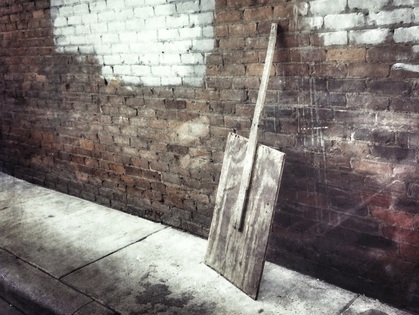
- Cambridge University Press, Cambridge Studies in Contentious Politics (2015)
INtro: For those that know me, they know that I refer to this book by the title "To Kill a Movement." This is the title that I used for years as I was thinking about and then working on the project. The publisher did not like it though, so there you go.
Overview: Conventionally researchers, policymakers, activists and general observers have suggested that social movements are killed either from the "outside" (e.g., from repression) or the "inside" (e.g., from activist burnout or fractionalization). This book explores how these two factors interact, noting that governments and challengers co-evolve with the one responding (or not) to the actions taken by the other. From my argument, challengers that lag in their response, respond in an inappropriate manner or develop bad habits which weaken the organization die. Those who stay up on their responsivity, respond in an appropriate manner to the threats they are confronted with and develop good habits survive. Governments have a certain advantage in this dynamic process (an ace in the hole, so to speak): not all that are in social movements are actually working with/for social movements themselves. Inside information (informants) and subversion (agents provocateur) facilitates effective government repressive action and organizational deterioration. To investigate this topic I use a very disaggregated and detailed analysis of a black nationalist organization (The Republic of New Africa) as well as diverse political authorities that sought to disrupt and destroy the organization (the FBI, Michigan State Police and the Detroit Police Department). The time period of interest is 1968 (the founding of the organization) to 1973 (when the original cohort is no longer engaged).
Contents
Introduction
Part I – Theory
1. Killing Social Movements from the Outside or the Inside
2. Killing Social Movements from the Outside and the Inside
Part II – Case
3. Repression and Red Squads
4. Record Keeping and Data Collection
Part III – Origins
5. We Shall Overcome? From GOAL to the Freedom Now Party
6. We Shall Overthrow! From the Malcolm X Society to the Republic of New Africa
Part IV – Examination
7. Birth of a Black Nation
8. To Ocean Hill-Brownsville and B(l)ack
9. New Bethel and the End of the Beginning
10. When Separatists Separate
11. Mississippi: The Last Stand(off)
Part V – Conclusion
12. Understanding the Death of Social Movement Organizations
Review Excerpts & Full Reviews
Review in American Journal of Sociology (2016) - "There is a great deal to admire about this book—from its astonishingly rich data and thorough analysis to its clear theorizing about an important and nettlesome issue in the study of repression (What are the consequences of repression?) to its call for research on demobilization".... "a must read"
Review in Social Forces (2015) - "Impressive"
Review in Mobilization (2014) - "theoretically-informative and conceptually-rich"... "The book comes highly recommended"
Book Blurbs
"Marshalling insightful analysis, brilliant archival research, and extensive knowledge, Davenport explains the emergence, growth, and demise of social movements. This book is a real gem."
-- Scott Gates, Peace Research Institute Oslo and Norwegian University of Science and Technology
"Christian Davenport presents us with new theoretical insights into the external forces and internal dynamics that can eventually lead to the demise of a social movement organization that at its inception was at the forefront of a broader movement. His analysis of archival information on both overt and covert forms of state repression as well as his scrupulous analysis of RNA internal documents present us with innovative methods and novel lessons for the study of how social movement organizations emerge and eventually die."
-- T. David Mason, University of North Texas
"Christian Davenport brings his expertise on political repression to bear on a question that has, oddly, been largely neglected by scholars: how and why do social movements die? Drawing on unusually rich data that take us inside the thought processes of movement actors as well as their opponents, Davenport offers deep insight into both the rise and demise of social movement organizations."
-- Rory McVeigh, University of Notre Dame
